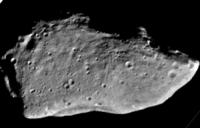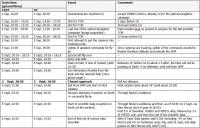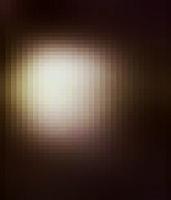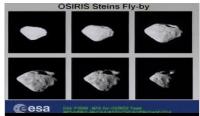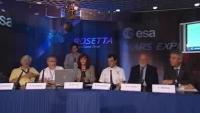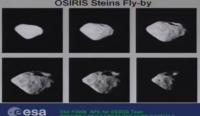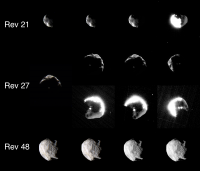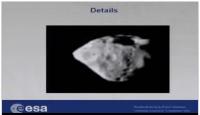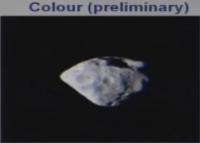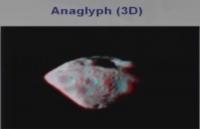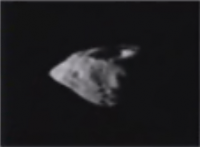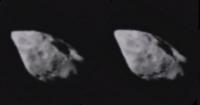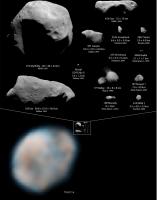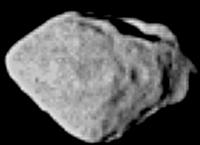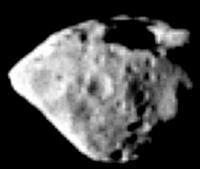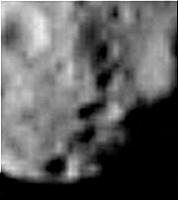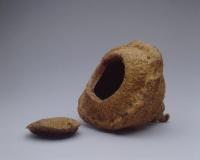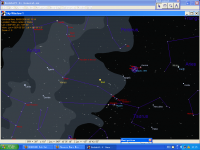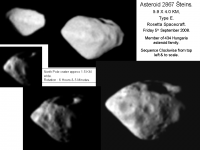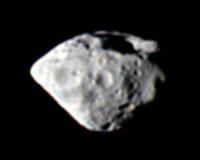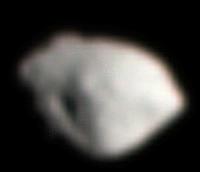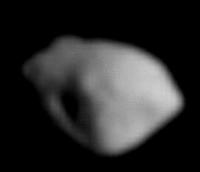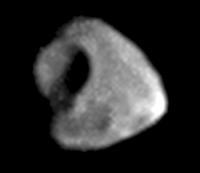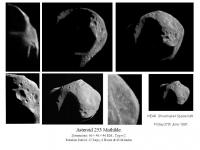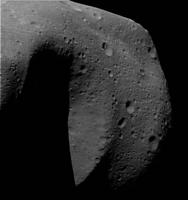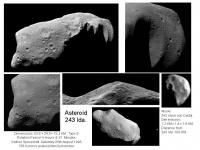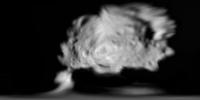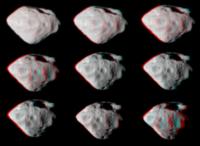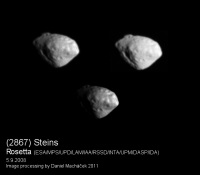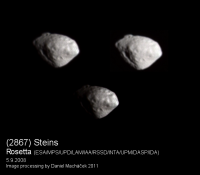Printable Version of Topic
Click here to view this topic in its original format
Unmanned Spaceflight.com _ Rosetta _ Rosetta flyby of Asteroid Steins
Posted by: peter59 Jun 19 2008, 06:53 AM
Only 78 days to Stein encounter ! I can't believe I forgot about this event.
Posted by: dmuller Jun 19 2008, 09:00 AM
Indeed, almost there ... 78 days and 121 million km to fly. Currently 61 million km away from Steins: http://www.dmuller.net/rosetta/
Does anybody have more details on the flyby trajectory? I currently have it nailed down to minute precision with closest approach being on 05 Sep 2008 18:35 spacecraft event time at a distance of 712 km
Posted by: ugordan Jun 19 2008, 09:05 AM
Anyone wanna bet if the previous flyby data (Earth, Mars) will hit the http://www.rssd.esa.int/index.php?project=PSA before or after this flyby?
Posted by: peter59 Jun 19 2008, 10:01 AM
PSA announcements:
First release of Rosetta data - early 2008 ??
First release of Venus Express data - July 2008 !?
http://www.rssd.esa.int/index.php?project=PSA
Posted by: jasedm Jun 19 2008, 10:11 AM
Perhaps it's time for a dedicated 'Steins' thread...
A few details on the rock:
Main belt asteroid
Discovered: November 4th 1969
Spectral type: E
Diameter 4.6km
Posted by: ugordan Jun 19 2008, 10:47 AM
That's just what they are: announcements.
Posted by: djellison Jun 19 2008, 10:58 AM
They had previously been announced ( both of them, iiirc ) as being earlier. I would essentially ignore the announcement dates and just wait for stuff to actually arrive.
Alice data is already available upto and including the most recent Earth flyby. No other instrument has provided anything to date.
Doug
Posted by: Paolo Jun 21 2008, 09:23 AM
Some details about Steins that I collected for the third volume of my book "robotic exploration of the solar system"
Steins is a small body less than 10 km across, discovered on 4 November 1969 by Soviet astronomer N. Chernykh at the Nauchnyj Observatory in Crimea and named after Karlis Steins, former director of the Latvian University Astronomical Observatory. While the properties of Lutetia, the second asteroid target are relatively well known, being a largish and bright object discovered more than a century ago, almost nothing was known about Steins, and observational campaigns were started in 2004 to characterize it. Steins was observed by the largest astronomical observatory on Earth, including the European Very Large Telescope (VLT) in Chile, JPL's Table Mountain Observatory, the Spitzer infrared astronomy satellite and Rosetta itself.
The Rosetta orbiter observed continuously Steins (1.06 AU away) for 24 hours with its science camera on 11 March 2006 in order to collect a “light curve” at phase angles larger than ever achievable from Earth, due to observational geometry constrains and for a longer time span, uninterrupted by day and night cycles. A total of 238 images were taken, covering four rotations.
Although researchers initially catalogued Steins in the S class (like most previously-visited bodies), the observational campaigns found that its spectral and polarimetric properties placed it in the E taxonomic class of reddish bodies with high albedo believed to be thermally evolved and of igneous origin, which underwent at least a partial melting and differentiation early in their history. E asteroid spectra probably makes them related to some rare enstatite chondrite or aubrite meteorites and therefore these bodies are believed to have a surface consisting of iron-free or iron-poor silicates. Observations pinpointed Steins' rotation period at about 6.05 hours, while the measured diameter could vary between 2 and 5 km, depending on its albedo. Asymmetries in the light curve confirmed that the small body has an irregular shape, with a ratio between the main axes of about 1.3. Other researchers pointed out that some of the characteristics of Steins could hint at a young and very rough surface at most a few million years old.
While fewer than 30 members of the E class of asteroids were known, including (44) Nysa, the largest, and two near-Earth objects, (3103) Eger and (4660) Nereus (a recurrent space mission target), little is known about the evolutionary history of the type. Steins was initially placed in the same family as (64) Angelina, but other studies showed that it shared most of the same spectral characteristics as Eger, both bodies being believed to be members of an old eroded family which formed in the inner asteroid belt close to the present position of Steins, which appears to be the largest member of the family. The presence of Eger in an Earth-intersecting orbit of course provides a path for enstatite and aubrite meteorites to hit our planet.
The encounter on 5 September 2008 will be at a distance of 1745 km and a relative speed of 8.6 km/s
Posted by: IM4 Jun 21 2008, 10:04 AM
Even more details for Rosetta fans !!!
Flyby in a nutshell:
- Closest approach on 5 Sept. 2008 18:33:57 ± 30 sec
- Heliocentric distance 2.14 AU, geocentric distance 2.41 AU
- Low phase angle during approach, high phase angle after closest approach, coverage 0-140°
- Minimum flyby distance of 800 km
- Zero phase angle will be reached at a distance of 1280 km
- One way light travel time will be 20 min
Flyby strategy
- Default pointing
- Spacecraft flip (T-40 min -> T-20 min)
- Inverted pointing (> T-20 min)
- +Z axis points at Steins at all times
Flyby Science:
- Alice: point at Steins to obtain FUV spectra search for exosphere/coma around Steins
- COSIMA: execute normal dust collection cycle
- GIADA: Impact sensor operational, but cover closed
- MIRO: Steins observations during approach and recession. Special asteroid mode sequence at closest approach (CA)
- ROSINA: Pressure monitoring, single mass measurement sequence
- RPC: Measurements of plasma environment
- RSI: Attempt for mass determination (probably not feasible)
- OSIRIS: Light curve for 2 weeks before CA for shape reconstruction. At CA: spectrophotometry, mapping and surface properties, satellite/dust search
- VIRTIS: Steins light curve determination starting 7 hours before CA. At CA: mineralogy mapping
Expected data volume:
- 600 MiB before closest approach
- 2400 MiB after closest approach
Posted by: tasp Jun 21 2008, 11:35 AM
Do we have any radar data indicating binary/satellite existence for any asteroid in this size range ?
Just wondering what the odds are for 'nother Dactyl type discovery. Would 200+ images for albedo study yield enough light curve data to rule out a satellite? Particularly one that was in an orbit inclined enough so that the satellite was never eclipsed or transited the primary.
Posted by: gpurcell Jun 21 2008, 03:31 PM
These sort of encounters always fascinate me...this is likely to be the only close approach data humanity collects on this particular hunk of rock for hundreds of years. Some time in the distant future an asteroid miner will pull up these old images on his way to this asteroid and wonder at the folks who sent a barbaric robot out to it....
Posted by: centsworth_II Jun 21 2008, 04:16 PM
I'm assuming this will be an AI robotic miner.
Posted by: nprev Jun 21 2008, 05:00 PM
Wasn't there an NEO radar-imaged by Aricebo that was a small binary object? It's certainly possible that Steins is binary or has a small satellite, but if so I suspect it would have to have been the product of a weak, recent impact event. There's not a lot of gravitation exerted by a 4.6 km body.
Posted by: tedstryk Jun 21 2008, 08:39 PM
There has been a multitude of such objects. Castalia was the first one. Arecibo and Goldstone will be observing the upcoming flyby of 2008 BT18 (July 6 and 7 for Arecibo, July 11 for Goldstone]. It will pass about 2.3 million kilometers away and is 700 to 800 meters across, so we should get some nice images and, with some luck, maybe another binary.
Posted by: jasedm Jun 25 2008, 04:21 PM
I couldn't find any relevant radar data, but it appears http://www.physorg.com/news93617655.html that a moon has been likely ruled out for Steins.
Posted by: tasp Jun 25 2008, 05:21 PM
Thanx for the article!
An idea springs to mind:
How far out from Pluto can New Horizons be and get good light curve data for Nix and Hydra? If we are lucky, perhaps so far out when nothing much else is going on ??
(I just love it when missions can 'cross pollinate' each other)
(If such observations for New Horizons are already scheduled, never mind)
Posted by: tty Jun 25 2008, 06:57 PM
Certainly there are earth-crossing binaries. There are several cases of multiple craters of equal age. Steinheim and Ries is the best example, but there are several other more or less certain cases. Even Chicxulub may be linked with Boltysh in Ukraine.
Posted by: cosmo Jun 29 2008, 10:15 AM
Around 15% or even more of the NEAs are suspected to be binary. Up to now more than 30 are confirmed out of 5000+ NEAs and most of them are less than 1500m in diameter. It seems the smaller the asteroid the better the chance it is a double.
The YORP effect is maybe the main forming mechanism of binary NEAs as most of them are very tiny. Other more uncommon forming mechanisms are collisions and tidal disruptions due to planetary close-encounter.
Posted by: Rakhir Jul 3 2008, 09:50 PM
Rosetta awakes from hibernation for asteroid encounter
http://www.esa.int/esaSC/SEMQPDSHKHF_index_0.html
Posted by: charborob Jul 4 2008, 02:35 PM
I've been doing some calculations. Rosetta's narrow angle camera has a field of view of 2,35 x 2,35 degrees. The image size is 2048 x 2048 pixels. At a distance of 800 km, if Steins is about 5 km wide, it will subtend an angle of about 20 arc minutes. At closest approach, Steins' image should then be about 300 pixels wide. That's not much, is it?
For comparison, here's an image of the asteroid Gaspra scaled to 300 pixels wide. That's about what we should expect from the Steins flyby. I didn't take motion blur into account. I don't know if it will be an issue.
If I made some errors, thanks for correcting me.
Posted by: tedstryk Jul 4 2008, 07:16 PM
To be fair, Gaspra is a much bigger asteroid - 18.2×10.5×8.9 km - and these are the best Galileo images at their original size. The larger image is a mosaic of two frames, but it just happened that the asteroid was imaged on the edge of the CCD - it could have easily fit in one frame. The smaller image is the next best shot at its original size (it is part of a color sequence). We often see the larger image in greatly enlarged forms and with a false color overlay from infrared data. 
Posted by: charborob Jul 4 2008, 08:49 PM
In my post, I was just trying to give an idea of what kind of detail we might expect to see on the surface of Stein during the flyby. By the way, the best resolution will be around 16 meters per pixel, if my data on the camera are correct.
Posted by: Ken90000 Jul 7 2008, 08:17 PM
The Cool thing about 2867 Steins is its type. We have never seen an “E” type asteroid at close range. Unfortunately, as you know, Steins is a tiny asteroid only 4.6 km in diameter.
There would be no point in approaching closer than the planned 800 km. Rosetta simply cannot track a body passing by so quickly. Remember, the spacecraft was designed to explore a comet while slowly orbiting the body.
I look forward to seeing what this body looks like even if the images are only a few hundred pixels across. Likewise, the data from spectrometers and other instruments should keep us occupied until the next flyby.
But, if you are looking for multi-image mosaics, you will have to wait for the 2010 flyby of 21 Lutetia.
Posted by: dvandorn Jul 8 2008, 04:11 AM
Let us hope that ESA doesn't do the same thing with Rosetta's Steins images as it did with the crescent Mars images that Rosetta supposedly acquired... *heavy sigh*...
-the other Doug
Posted by: ugordan Jul 8 2008, 07:29 AM
I'm actually willing to let that one pass for them. Reportedly, the images were saturated and not very useful for release so we're probably not missing as much as you think (think CCD charge bleed for example).
Posted by: djellison Jul 8 2008, 11:45 AM
Crime 1. Not sequencing a normal RGB sequence during that phase in between the long exposures for dust obs.
Crime 2. Not releasing whatever they did take, either for press release at the time, or via the PDS to date.
But let's not have that debate again - the E2 flyby was quite well 'blogged' - and I expect the Steins flyby will be as well. If I hadn't taken all my time off for Europlanet and IAC - I'd be asking to visit ESOC during the flyby.
Doug
Posted by: ugordan Jul 8 2008, 11:55 AM
Crime 2 definitely stands. It's ironic that the comment on the PSA site doesn't even mention OSIRIS data as pending for review, unlike a few of other instruments. I'm keeping my eye on this as no doubt others are, but somehow this doesn't instill confidence we'll be seeing OSIRIS data any time soon.
Second the E2 flyby comment, it was pretty nice. Although, as an imaging kind of person I was left wanting more than 3 images. Not sure if they've been taken at all, though.
Posted by: cotopaxi Jul 14 2008, 03:36 AM
Well, it depends on the size of the moon. A moon of a size comparable to that of Steins is probably ruled out, but for example a 100 m sized satellite would create only 1/2500 of the signal from Steins (assuming 5 km diameter for Steins and equal albedo), and that would not be detectable in the Rosetta lightcurve (and I suspect in no other data set).
Posted by: tasp Jul 14 2008, 12:56 PM
The article indicates light curve data was taken from 159 million kilometers out!
Seems like looking for opportunities to observe Tempel 1 might be useful. (yes I know it's a comet and light curve data might be harder to interpret)
Are there instruments comparable to OSIRIS on other spacecraft ?
Posted by: cotopaxi Jul 15 2008, 03:59 AM
Full quote of previous post removed - mods
OSIRIS observed Tempel 1 for two weeks around Deep Impact. See http://www.esa.int/SPECIALS/Rosetta/SEMUSK5Y3EE_0.html and http://www.esa.int/SPECIALS/Rosetta/SEMSJ06DIAE_0.html
What would we learn from observing Tempel 1 with OSIRIS now?
The High resolution camera on Deep Impact may be comparable with OSIRIS. Bigger telescope on one hand, focus problem and inferior CCD on the other hand. I don't know how SSI on Cassini compares.
Somewhat off topic here: OSIRIS is going to look for the parallax effect in gravitational microlensing in September, after the Steins flyby.
Posted by: tasp Jul 15 2008, 12:18 PM
IIRC, a craft will eventually return to Tempel 1, if light curve could be worked out, perhaps encounter could be timed to observe Deep Impact crater on the dayside.
Light curves for Nix and Hydra, from as far out as possible (if made by NH) are quite desirable too. Tidal braking effects for those 2 objects (from Pluto) appear to be quite small. Rotation rates other than synchronous to Pluto would be very interesting. So would satellites of Nix and Hydra. Maybe something analogous to Mercury (3:2) would be interesting too. A debris belt (like Rhea's) ????
I was also curious if Pluto's hill sphere has objects similar to Phoebe or Nereid (but smaller) and perhaps some 500 meter to 1km objects might be looked for too when NH is close enough to 'see' them in long exposures. I am thinking the observatory phase for the NH Pluto encounter could be very interesting.
Posted by: tedstryk Jul 15 2008, 01:43 PM
And that couldn't be done from earth because why?
They do seem to have the flyby pretty well planned.
http://www.astro.cornell.edu/next/noannot.mov
http://www.lpi.usra.edu/meetings/acm2008/pdf/8053.pdf
Posted by: tasp Jul 15 2008, 02:04 PM
I am just trying to find activities for NH when it is further out from Pluto and less busy. The earlier anything new and unexpected is found in the Pluto system, maybe we have time to reprioritize the flyby. (not that Alan Stern needs more work ![]() )
)
Nix and Hydra are so faint, tying up HST for light curve data seems not a good use of assets, especially if NH can make similar or better observations during later cruise phase.
I just don't know effective magnitude limits for NH instruments and when various objects in Pluto system become usefully visible. That other craft in solar system are making (to me) surprising studies from great distances (159 million kilometers!!) seems to suggest useful info might be possible from other missions too, and at surprising distances. When do the orbits of Nix and Hydra subtend more than, let's say, 10 arcseconds, as seen from NH?
(Thanx for the Tempel 1 info, I didn't know they had the rotation period accurate enough to know now which hemisphere would be visible during next flyby)
Posted by: ugordan Jul 15 2008, 02:23 PM
Unless some clever data reduction scheme is implemented, NH would have to return full LORRI frames for lightcurves, AFAIK. Is that really feasible/worth it given the immense distances by then and consequently low bitrates?
Posted by: plasmatorus Jul 28 2008, 04:45 PM
Does anybody have more details on the flyby trajectory? I currently have it nailed down to minute precision with closest approach being on 05 Sep 2008 18:35 spacecraft event time at a distance of 712 km
The nominal time for Rosetta's closest approach to Steins is 2008-09-05 18:37:48 +/- 20s. Flyby distance will be 800 km.
Posted by: dmuller Jul 29 2008, 10:49 AM
Thanks plasmatorus for the flyby time and Emily for the forwarded timeline which I have incorporated into the realtime simulation at http://www.dmuller.net/rosetta ... and yes, I have fixed the problem I had with the database at least for the Rosetta mission
Posted by: Paolo Aug 2 2008, 05:51 PM
Note that there are three papers on Steins for publication in http://www.aanda.org/index.php?option=forthcoming&Itemid=18:
Asteroid 2867 Steins.I. Photometric properties from OSIRIS/Rosetta and ground-based visible observations
L. Jorda, P. Lamy, G. Faury, P. Weissman, M. A. Barucci, S. Fornasier, S. Lowry, I. Toth, and M. Kuppers
Asteroid 2867 Steins.II. Multi-telescope visible observations, shape reconstruction, and rotational state
P. L. Lamy, M. Kaasalainen, S. Lowry, P. Weissman, M. A. Barucci, J. Carvano, Y.-J. Choi, F. Colas, G. Faury, S. Fornasier, O. Groussin, M. D. Hicks, L. Jorda, S., A. Kryszczynska, Larson, I. Toth, and B. Warner
Asteroid 2867 Steins.III. Spitzer Space Telescope observations, size determination and, thermal properties
P. L. Lamy, L. Jorda, S. Fornasier, O. Groussin, M. A. Barucci, J. Carvano, E. Dotto, M. Fulchignoni, and I. Toth
Posted by: remcook Aug 4 2008, 12:20 PM
Optical tracking has started (includes image of Steins, but doesn't seem real from the description...confusing)
http://www.esa.int/esaCP/SEMF0B8N9JF_index_0.html
Posted by: cotopaxi Aug 4 2008, 01:09 PM
I am not sure what exactly is unclear, but let me try to be a bit more quantitative:
Today OSIRIS and the NAVCAM start to look at Steins for navigation purposes, twice a week for the first 3 weeks, than daily until and including Sept.4
Currently the astrometric accuracy from OSIRIS is about the same as the current knowledge of the position of the asteroid, the NAVCAM will reach that accuracy in about 3 weeks.
The asteroid will be unresolved in both OSIRIS and NAVCAM during the whole navigation campaign.
The hope is that after the last slot, the absolute position of Steins, perpendicular to the flight direction, will be known to about 2 km (compared to of the order of 100 km now).
There are four slots for trajectory correction maneuovers, one mid-august, the others in the last days before closest approach. The slots will be used if at that point the flyby geometry can be significantly improved (predicted vs. planned flyby geometry). The parameters are the closest approach distance of 800 km and the passage through 0 phase angle.
The astrometry will not much improve the knowledge of the position of the asteroid in flight direction (in other words distance). This corresponds to an uncertainty in the time of closest approach of roughly 10 seconds.
Posted by: remcook Aug 4 2008, 01:25 PM
thanks for the explanation.
sorry, my confusion was with the origin of the image of Steins. Is it an artist impression? It looks pretty realistic!
Posted by: cotopaxi Aug 5 2008, 08:26 AM
Ah, ok, yes, that's confusing. It guess it is some sort of simulated image or artist impression. Apart from the fact that there is no image of Steins yet, the stars are much too bright compared to the asteroid for the image to be real.
Posted by: remcook Aug 5 2008, 08:37 AM
Thanks again, much appreciated! Looking forward to the real images of Steins ![]()
Posted by: Paolo Aug 12 2008, 12:01 PM
the three papers are now available. I guess this is the best we can hope to know about Steins for a few weeks more...
http://www.aanda.org/articles/aa/abs/2008/33/aa8994-07/aa8994-07.html
http://www.aanda.org/articles/aa/abs/2008/33/aa8995-07/aa8995-07.html
http://www.aanda.org/articles/aa/abs/2008/33/aa8996-07/aa8996-07.html
Posted by: jasedm Aug 12 2008, 12:32 PM
The discoverer of Steins died a few years back, but his widow Lyudmila Chernyk is still alive (according to Wikipedia), and working for the Crimean Astrophysical Laboratory. The coming flyby must be of extra special interest to her.
It would be nice to think that the IAU in the fullness of time named a crater each in their honour.
Posted by: cndwrld Aug 13 2008, 08:57 AM
Here is some information on the flyby. I tried to include the timeline, but I'm not familiar with the BB code so I don't know if it will show up. The timeline is in Word table format, and I couldn't figure out how to show it. So I just created a JPG of it and tried to attach it.
Fly-by operations
Rosetta will be closest to Steins on 5 September 2008 at 20:58 CEST (= 18:58 UT, ground time). The minimum distance from the asteroid will be 800 km. This is the minimum distance from which Rosetta is able to track the asteroid continuously.
Rosetta will pass by Steins very fast, at a speed of 8.6 km/s relative to the asteroid. This means that the distance between Rosetta and the asteroid will change very rapidly (by a factor of 10 within 15 minutes before and after the fly-by), and the asteroid will quickly diminish in the cameras’ field of view.
Between 40 and 20 minutes before closest approach, Rosetta will be flipped and readied to enter the asteroid fly-by mode (AFM). During this mode, the orientation of the spacecraft is automatically driven by the navigation cameras to continuously keep the asteroid in the field of view of the imaging instruments.
Although most scientific observations will be performed in the few hours around closest approach, several instruments will be on for a few days around closest approach.
Communication with Earth will take place through ESA’s New Norcia Deep Space antenna as the main station. NASA’s DSN Goldstone, Canberra and Madrid stations will provide support for tracking before closest approach and for science operations, filling the gap in visibility between Cebreros and New Norcia after closest approach. ESA’s Cebreros Deep Space antenna will be used in the 2 days preceding closest approach. Radio signals to and from Rosetta (located at 2.41 Astronomical Units, or about 360 million km from Earth at the time of fly-by) will take 20 minutes to travel to their destination.
A timeline of the main fly-by operations is given below:
CA = Closest Approach;
TCM = Trajectory Correction Manoeuvre;
AFM = Asteroid Fly-By Mode
HGA = High Gain Antenna
Spacecraft time = UT ground time – 20’
There will be material released in the run-up to the flyby, including video- and pod-casts and a web blog. Media activities start at ESOC, Darmstadt at 18:00 CET on Friday, 05 Sept. On Saturday, 06 Sept from 12:00 - 13:00 CET, the results of the flyby will be presented at ESOC and placed on the web pages.
Posted by: mchan Aug 14 2008, 01:44 AM
Thanks for posting this description.
Hope to see lots of images then.
Posted by: cndwrld Aug 14 2008, 07:22 AM
Ahhh, don't we all...... But as in the past, I expect we'll see a handful of press conference pictures. Still, they should be very cool pictures.
Posted by: cndwrld Aug 18 2008, 07:49 AM
nth Asteroid Flyby
I was wondering about this question, and searches didn't give me an answer. As Rosetta gears up for the flyby of Steins, how often has an asteroid flyby been done before? Is this the second time, or the fifth? It would be great if one of you space historians could put this into focus.
Posted by: djellison Aug 18 2008, 09:17 AM
Ones I can think of
Galileo did Gaspera, then Ida & Dactly (that's only one flyby though - Dactyl was just gravy )
NEAR did Maltide then EROS, then orbited Eros
Stardust did Annefrank
DS1 did Braille ( although that didn't go well )
6 proper planned ones then I think.
Technically, NH did 132524_APL, and Cassini did http://en.wikipedia.org/wiki/2685_Masursky - but they're more of a distant encounter rather than flybys.
Posted by: PhilCo126 Aug 18 2008, 11:19 AM
Don't forget Hayabusa... and the cometary fly-bys ![]()
Posted by: djellison Aug 18 2008, 11:58 AM
Hayabusa was a rendezvous and orbit, and well, a comet flyby doesn't count as an asteroid flyby, does it ![]()
Posted by: cotopaxi Aug 18 2008, 04:41 PM
Some information and images from the navigation campaign:
http://www.esa.int/esaCP/SEMC9R6UWJF_index_0.html
Posted by: tasp Aug 18 2008, 11:42 PM
I recall Carl Sagan finding difficulty in scheduling observing time from Mariner 9 (IIRC) of Phobos and Deimos since they were not mentioned in the 'official' mission plans.
He advanced the idea that studying Phobos and Deimos at Mars was the equivalent of a free mission to the asteroid belt, and this point seemed to do the trick.
Happily, all these years later, can we really categorize all these wee rocky beasties accurately ??
So many weird and wonderful objects to study, and they all are unique in their own ways.
Posted by: tallbear Aug 19 2008, 07:41 AM
He advanced the idea that studying Phobos and Deimos at Mars was the equivalent of a free mission to the asteroid belt, and this point seemed to do the trick.
Happily, all these years later, can we really categorize all these wee rocky beasties accurately ??
So many weird and wonderful objects to study, and they all are unique in their own ways.
and Cassini is doing plenty of asteroid flybys as it gets closer looks at Saturn's fine collection of asteroids
.... T
Posted by: ugordan Aug 19 2008, 08:20 AM
Well, "closer looks" is a bit misleading, don't you think? I'd declare something a flyby if the s/c actually resolved the object. Photometry and light curves are stretching it a bit, IMHO.
Posted by: jasedm Aug 19 2008, 08:24 AM
This is a great way of characterising the small moon flybys in Cassini's schedule. I think Tallbear is referring to everything inside of Phoebe's orbit rather than the 30 or so rocks in eccentric/inclined orbits further out
Whilst the small inner moons may or may not be captured asteroids, the 24-for-one Cassini mission (Saturn plus 23 moons at reasonable ranges) is fantastically good value.
Cassini conducts a 'flyby' today of Pallene at 61,000km - a moon completely unknown before 2004. Were this a Rosetta flyby (or New Horizons) of an asteroid at that sort of range, the media and other interest would be much higher than it is.
Perhaps we've come to take Cassini's results for granted a little ![]()
Posted by: PhilCo126 Aug 19 2008, 05:46 PM
Stardust is still on route for another flyby with Tempel-1 ( a comet - I know ), which was impacted by Deep Impact in July 2005.
The latter spacecraft couldn't observe the impact crater due to the dust & debris flying away from the comet, so Stardust will take a look in the year 2011...
Posted by: JRehling Aug 19 2008, 06:34 PM
FWIW, of all of the small inner satellites of Saturn inside Phoebe's orbit, the farthest out is only at 2.9% of Phoebe's semimajor axis. "Inside Phoebe's orbit" is quite an overstatement. I doubt if anything that deep in Saturn's satellite system can be presumed to have retained the characteristics of an asteroid from outside the system, but small bodies do tend to be similarly nonspherical.
Posted by: elakdawalla Aug 25 2008, 03:47 AM
This is a bit late of a reply because of my vacation, but I'll point out my post http://planetary.org/blog/article/00001611/, which shows the 7 asteroid systems (8 bodies total) and 4 comets that have been imaged to date. And don't forget Vega 1 and Giotto also imaged Halley. So depending on how you add things up you can come up with anywhere from 11 to 14 "encounters."
A number of people have requested a single-image version of my scale montage -- I have that together and will post it this week as soon as I round up the image credits.
--Emily
Posted by: stevesliva Aug 25 2008, 04:07 AM
I thought it was awesome, too. I had no idea that Mathilde was the biggest of the bunch, the quality of the Galileo images is particularly deceiving... would have bet they were bigger. One with Phobos and Deimos would also be interesting. I just looked at the stats and was surprised to see the Phobos is also smaller than Mathilde. And I knew Itokawa was small, but indeed I had a poor conception of scale there versus Eros.
Posted by: PhilCo126 Aug 25 2008, 09:24 AM
Correction Emily;
a single-image version of Your SUPERB scale montage ![]()
Posted by: jasedm Aug 25 2008, 02:45 PM
I second that sentiment - nice job Emily. It's very useful to see these bodies at the same scale - it underlines the point that they really are all unique worlds in their own right.
The image reminds me of another similar, excellent montage put together by Exploitcorporations of the smaller Saturnian moons http://www.unmannedspaceflight.com/index.php?showtopic=4417&hl
I can't wait to see how Steins (and later, Lutetia Ceres and Vesta) fit into the mix.
Great times!
Posted by: peter59 Aug 25 2008, 07:33 PM
- The closest approach to Steins is due to take place on 5 September at 20:58 CEST (Central European Summer Time).
- First ground contact with the spacecraft and announcement of successful fly-by will take place at 22:23 CEST.
- The first data and images collected by Rosetta will be sent to Earth throughout the night of 5 to 6 September and will undergo preliminary processing in the morning of 6 September.
- First images and results will be available for presentation to the media during a press conference which will be held at ESOC the following day, Saturday 6 September at 12:00 CEST.
Posted by: PhilCo126 Sep 2 2008, 12:37 PM
Rosetta blog:
http://webservices.esa.int/blog/blog/5/
Posted by: djellison Sep 2 2008, 12:55 PM
Ahh - good stuff - I thought the last Earth flyby was a nice job by the blog team.
Posted by: stewjack Sep 2 2008, 04:25 PM
http://www.esa.int/SPECIALS/Operations/SEMUUBO4KKF_0.html
Timeline of nominal fly-by events
Note: All event times are stated in ground time, CEST.
Time Event
..... snip ....
6 September
12:00 Live streaming of Rosetta Steins fly-by press conference from the European Space Operations Centre begins
13:00 Images from fly-by published on ESA web
15:00 End of press conference streaming
16:01 End of reception of first set of science data
===========
Does anyone have the link to this and maybe also the offset of CEST from GMT/UTC?
Jack
Posted by: peter59 Sep 2 2008, 04:35 PM
CET - Central European Time
CEST - Central European Summer Time
Standard Time = GMT+1
Summer Time = GMT+2
Posted by: stewjack Sep 4 2008, 06:42 PM
This Coverage of Rosetta Steins fly-by will probably be to early for me but if anyone else is interested here is the information. -
Sat, Sep 06, 2008 | 04:00 - 11:20 GMT | 06:00 - 13:20 CET| 05:00 - 12:20 BST
WEB Page
http://television.esa.int/sche_detail.cfm?id=2236
ESA TV Live
The feed at 04:00 GMT will feature key moments of this exceptional flyby including the very first reactions of spacecraft controllers and scientists at ESA's Space Operations Centre (ESOC) in Darmstadt, Germany, as the very first data and pictures arrive throughout the night between 5 and 6 September.
An additional TV feed may be made at 08:00 GMT on 6 September - please watch for announcements.
The first batch of processed images and preliminary results will be presented at a press conference taking place at ESOC starting at 10:00 GMT / 12:00 CEST on 6 September (available through web and TV streaming). David Southwood, ESA Director of Science and Robotic Exploration, Gaele Winters, ESA Director of Operations and Infrastructure, and the key scientists and experts for the Rosetta mission, will provide the first insights into the outcome of this historic fly-by and link them to the bigger picture of space debris monitoring at ESA.
Webcast - http://www.esa.int/rosetta.
Jack
Posted by: PhilCo126 Sep 5 2008, 11:38 AM
For the Press conference, also:
http://www.esa.int/SPECIALS/Rosetta/SEMW4V0SAKF_0.html
Posted by: dmuller Sep 5 2008, 05:26 PM
Closest approach now just over 1 hr 15 minutes away. Seems that the C/A time has changed to 20:38:14 SCET/CEST which is about 30 secs after what I have in my simulation (too late to change now). Happy blogging at http://webservices.esa.int/blog/blog/5/
EDIT: Nice to see an increased traffic on the realtime simulation. Shows there is a good interest in this mission. Now let's see whether the Rosetta@Steins peak exceeds the Cassini@Enceladus peak from last month.
Posted by: ElkGroveDan Sep 5 2008, 05:32 PM
COMMAND 0001: "remove lens cap "
Posted by: climber Sep 5 2008, 06:38 PM
Unnecessary full inline quote removed - mod.
The fly- by is occuring in another 22 minutes or so and my understanding is that press conf etc will be in another 3h30 minutes approx.
Either you're wrong or I am regarding your time line
Thank you to confirm or not my take
Posted by: imipak Sep 5 2008, 07:22 PM
Climber - if stewjack's got it wrong then so have ESA; that info is straight from their website.
Posted by: climber Sep 5 2008, 09:11 PM
Edited : I'm still not sure what time I'll have to be up tomorrow morning! Good night anyway...
Posted by: tedstryk Sep 5 2008, 10:50 PM
So, no images yet. I take it ESA is hiding behind the old "the flyby hasn't happened yet, so there are no closeup images yet" excuse. I'm not buying....
Sorry Ustrax, I had to do that just for you ![]()
Posted by: Hungry4info Sep 5 2008, 10:58 PM
Definitely looking forward to some images ^_^
I'm not very good with working out time zones, I get confused and frustrated really easily... =( How long from now is the press conference supposed to occur?
Posted by: elakdawalla Sep 5 2008, 11:43 PM
Hungry4info: Here's my favorite Web resource for figuring out what time something is: http://www.timeanddate.com/worldclock The ESA Web briefing starts at 11:55 CEST. http://www.timeanddate.com/worldclock/fixedtime.html?month=9&day=6&year=2008&hour=11&min=55&sec=0&p1=37
--Emily
Posted by: Hungry4info Sep 5 2008, 11:57 PM
--Emily
Oh, wow, that was much more comprehensible than the other sites I found. Thank-you for the link ^_^. It'll be ~5 AM for me when it comes on... going to pull an all-nighter
Posted by: volcanopele Sep 6 2008, 12:28 AM
Sure I might as well.
Now taking bets on the object that it can best be compared to. I am leaning toward armadillo.
Posted by: tasp Sep 6 2008, 01:01 AM
Itokawa and Eros had a love child with a bad attitude.
Posted by: elakdawalla Sep 6 2008, 02:11 AM
I'll bite. I'll guess: Guinea pig.
--Emily
Posted by: dvandorn Sep 6 2008, 02:28 AM
Potato. Definitely potato.
![]()
-the other Doug
Posted by: ElkGroveDan Sep 6 2008, 02:56 AM
I'll say a yam.
Posted by: vjkane Sep 6 2008, 03:38 AM
since all the obvious ones are taken, Snoopy!
Posted by: lyford Sep 6 2008, 04:03 AM
http://webservices.esa.int/blog/post/5/426
Patience, people!
Posted by: Hungry4info Sep 6 2008, 04:39 AM
I suppose I'll guess a fractal pattern, lol.
Yeah that's what I was thinking, too. Certainly is a confusing statement. Perhaps it's a joke? Sort of like a "Oh by the way, Steins isn't an alien mothership"?
Posted by: nprev Sep 6 2008, 05:43 AM
Okay...I'm gonna go with "fat-hockey-puck-looking-thingy-with-a-couple-of-chips-knocked-out-of-it".
More specific than that I cannot be.
Posted by: climber Sep 6 2008, 06:43 AM
On top of all different time zone there is this "am" "pm" that we do not use in most of EU countries :it's 1 to 24 and that's it.
BTW, what about sols on Mars?
Posted by: ustrax Sep 6 2008, 07:39 AM
Dear Ted...you MUST admit that things are changing for better... ![]()
I didn't found Paolo Ferri's statement confusing...Rosetta's the rock...solid as a rock...
And now...exclusive for UMSF!...the first Steins image ever seen outside ESA's realm!
![]()
From http://webservices.esa.int/blog/gallery/5/060920081904.jpg...
Posted by: lyford Sep 6 2008, 07:42 AM
GO USTRAX!!!! ![]()
Of course, it's the Rosetta STONE....
Posted by: Philotas Sep 6 2008, 07:44 AM
From their blog:
The first image data is in now and the team is analysing it, as I type. So far it looks very promising, and we expect to publish some amazing images at 13:00 hrs.
Surely a typo..
Posted by: ustrax Sep 6 2008, 07:47 AM
You asked for it...
Now the question is...was that guy looking at a Steins image?...
Posted by: Tman Sep 6 2008, 07:59 AM
Hehe, would be cool if it's congruent with the real shape. Probably somehow it will be ![]()
Posted by: Rakhir Sep 6 2008, 08:41 AM
"The first image data is in now and the team is analysing it, as I type. So far it looks very promising, and we expect to publish some amazing images at 13:00 hrs."
Surely a typo..
No, first images are expected to be published on the web 1h after the beginning of the press conf, so at 13:00 (http://www.esa.int/SPECIALS/Operations/SEMUUBO4KKF_0.html)
Posted by: lyford Sep 6 2008, 08:50 AM
Crikey!
1:45 am PST and some Cabernet Franc tell me it's time to check in the morning.... sorry this San Diegan can't stay up for the real time ESA downlink.....
Thx Ustrax for the pixelated preview peek! ![]()
Posted by: Toma B Sep 6 2008, 09:01 AM
What is "I type" asteroid???
The first image data is in now and the team is analysing it as I type. So far it looks very promising, and we expect to publish some amazing images at 13:00 hrs.
The download of the OSIRIS imaging system data started at 02:00 CEST, and is still ongoing.
The VIRTIS (infrared spectrometer) data download began an hour ago, and will be completed in about two hours. We’ve heard that the team in Italy at INAF, Rome, is on stand-by, and are eager to get their hands on the data.
We’ve also just been told that the housekeeping data for VIRTIS looks nominal.
--Amruta
Posted by: tedstryk Sep 6 2008, 09:04 AM
..
They definitely are. I just couldn't resist the opportunity...
Posted by: Toma B Sep 6 2008, 09:07 AM
This is what we were expecting?
Orbital Radius_______353 million km
Class______________E-type asteroid
Rotation Period______approximately 6.05 hours
Shape_____________irregular but not elongated
Closest approach____5 September 2008, 20:58 CEST
http://en.wikipedia.org/wiki/Asteroid_spectral_types
Posted by: ustrax Sep 6 2008, 09:11 AM
Toma B...you are joking right?...
Ted...I'm starting to question who can't change...ESA or you?...
Can someone make something out of the images on the laptop to the left?...
I'm reduced to Paint in this one...
Posted by: climber Sep 6 2008, 09:50 AM
Press conf in less than 10 minutes
Posted by: Hungry4info Sep 6 2008, 10:07 AM
It has started.
Posted by: Stu Sep 6 2008, 10:12 AM
Gerhard has been given Lou Friedman's mic from the UStream chat, obviously... ![]()
Posted by: elakdawalla Sep 6 2008, 10:20 AM
There's a dropdown menu from which you can select different feeds -- I'm finding the "Flash 400k" to be a larger image and to have much clearer audio than the default.
Good morning, everyone!
--Emily
Posted by: Stu Sep 6 2008, 10:22 AM
Morning Emily! Isn't it great to have a live ESA event like this? Well done to everyone involved I say! ![]() ESA is definitely making progress here.
ESA is definitely making progress here.
Posted by: Hungry4info Sep 6 2008, 10:23 AM
Indeed, I'm quite happy with this new progress and hope ESA continues being this open.
Posted by: Astro0 Sep 6 2008, 10:25 AM
We're watching in Australia too!
Morning?? Evening!! ![]()
Astro0
EDIT: Emily, they should have used your asteroid scale graphic.
Posted by: djellison Sep 6 2008, 10:28 AM
I think they are - the VMC images, the Rosetta blog - they're beginning to 'get it'. Osiris and Navcam images straight onto the web overnight would have been the full gold standard
Doug
Posted by: Stu Sep 6 2008, 10:31 AM
That's a VERY poor model of a dalek on the right hand side of the table, tho... ![]()
Posted by: ustrax Sep 6 2008, 10:35 AM
Doug
Step by step...step by step...Doug...
Guess we can assume that we are "guilty" for part of this change...aren't we?
I believe that, beside its inner policy, ESA wasn't really aware that there were so many people interested in their endeavours...since they earn that conscience things have been changing in a quite quick manner...
Astro0...you took the words out of my fingers...
Posted by: djellison Sep 6 2008, 10:39 AM
I would like to think so. We've made progress, we've got some still to make - but we are getting there
Posted by: elakdawalla Sep 6 2008, 10:40 AM
--Emily
Posted by: djellison Sep 6 2008, 10:46 AM
9 minute before closest approach the OSIRIS-NAC turned off and entered safe mode.
Oh hell.
Posted by: Hungry4info Sep 6 2008, 10:48 AM
=O OMG Gigantic crater on top.
Posted by: ustrax Sep 6 2008, 10:49 AM
There's the little sucker!
Edited: You guys are REALLY fast...removed my own... ![]()
That baby has been quite beaten! ![]()
Posted by: djellison Sep 6 2008, 10:51 AM
I had grab open, set to 'selection' - photoshop open ready to go, and the attach file dialogue already open ![]()
Posted by: ugordan Sep 6 2008, 10:52 AM
I got the impression this was planned. Not sure why.
Posted by: djellison Sep 6 2008, 10:54 AM
Uwe used the phrase Safe Mode - which I wouldn't have thought would without it being an off nominal event.
Anaglyph - good man ![]()
Posted by: peter59 Sep 6 2008, 10:55 AM
9 minutes = 4650 km
Posted by: climber Sep 6 2008, 10:57 AM
Cut according to dotted lines
Posted by: belleraphon1 Sep 6 2008, 11:00 AM
Good Day everyone...
Nice job ESA!!!! Even without NAC at closest approach..... wish they had turned on the dust detector though....
Craig
Posted by: TheChemist Sep 6 2008, 11:04 AM
Good day everyone !
Another chair would be usefull ![]()
Posted by: Astro0 Sep 6 2008, 11:04 AM
If she just gives UMSF the data, we'll get it done for them!
BTW - is that an orange traffic cone on the front of the stage?!
EDIT: everyone is getting a chance to speak at this press conference. They are obviously all very excited.
Next up....the Janitor! ![]()
Posted by: djellison Sep 6 2008, 11:13 AM
Ahhh - looks like ESA is setting up a NEO program. If they can stretch this out for about 20 minutes, it'll be timed perfectly to start watching qualifying for the Belgium Grand Prix Qualifying.
Posted by: elakdawalla Sep 6 2008, 11:15 AM
I really hope they don't...I would love to get a little more sleep...
Here's a PSD file (zipped) with a boatload of screen caps.
--Emily
Posted by: elakdawalla Sep 6 2008, 11:21 AM
Images are up
http://www.esa.int/SPECIALS/Rosetta/SEMNMYO4KKF_0.html
Posted by: djellison Sep 6 2008, 11:22 AM
Sounds like they just set some very conservative watermarks for the NAC, it went into safemode, and then came out a few hours later.
Doug
Posted by: ugordan Sep 6 2008, 11:23 AM
Looks like the NAC safe mode was indeed inadvertent. Overheating? Was this the most stressful operation of NAC so far? If so, electronics heating up combined with suboptimal s/c orientation could well have caused this.
Posted by: ustrax Sep 6 2008, 11:23 AM
ESA's work is great now we just need decent journalists to make decent questions... ![]()
4 questions so far...two about the antenna problem and two about the NAC problem... ![]()
Posted by: belleraphon1 Sep 6 2008, 11:24 AM
Sounds like the NAC turn off was intentional? Or not... ? Data delay but all will get onto the ground.
Glad to see another NEO program going.... more monitoring the better.
About time for my morning shower ....
Craig
Posted by: dilo Sep 6 2008, 11:27 AM
Thanks to all for great coverage, especially to Emily!
This is a rough crossed-eye stereogram from last two frames of Astro0 animation:
Posted by: OWW Sep 6 2008, 11:29 AM
Stupid journalists. Am I the only one who really wants to know if the last images the NAC took were better than the best WAC images? ![]()
Posted by: belleraphon1 Sep 6 2008, 11:29 AM
Doug...
you are right... software parameters for NAC were conservative. As they should be to preserve the instrument for it's main goal... the comet.
Look forward to Emily adding Steins...
My morning has just started and gotta go....
Craig
Posted by: elakdawalla Sep 6 2008, 11:30 AM
OK, I'm going back to bed now.
If I may make a little request...it would be wonderful if when I woke up I found a version of one of these images at 20 m per pixel ![]() I want to add it to my comparative graphic but my brain is too tired for me to scale it properly right now!
I want to add it to my comparative graphic but my brain is too tired for me to scale it properly right now!
Emily
Posted by: ugordan Sep 6 2008, 11:32 AM
The press release states the last NAC frames will have a resolution comparable to WAC c/a imagery. FWIW, the images so far look magnified 2x to me.
Posted by: TheChemist Sep 6 2008, 11:34 AM
"The OSIRIS imaging system's Wide Angle Camera (WAC) worked perfectly through the fly-by.
The OSIRIS team expects that the images that they will retrieve from the Narrow Angle Camera (NAC) will be of comparable resolution. This will add to the detailed colour information and hence to knowledge of the surface composition."
From the http://www.esa.int/SPECIALS/Rosetta/SEMNMYO4KKF_0.html with the conference images, which just came up.
Posted by: Stu Sep 6 2008, 11:38 AM
Well, that went pretty well, I think. ![]() Definitely an improvement by ESA on how they handle these things, although the build-up to the big reveal of the pics was a bit drawn-out, I have to be honest. ( Could have been summed up by: "This was a very hard thing to do, what with turning and twisting the probe around and everything, but we have some really clever and dedicated people here and hey, they did it! Now, here are the pictures you all want to see..."
Definitely an improvement by ESA on how they handle these things, although the build-up to the big reveal of the pics was a bit drawn-out, I have to be honest. ( Could have been summed up by: "This was a very hard thing to do, what with turning and twisting the probe around and everything, but we have some really clever and dedicated people here and hey, they did it! Now, here are the pictures you all want to see..." ![]() )
)
Seriously tho, this has to be a good sign, a much more open way of doing things. ESA is now blogging events and encounters (well done Daniel Scuka), the VMC is going to really take off I think (well done Tom!), and the media conference - although very heavy on the science in the first... 40 minutes... - was less stuffy than I expected. Now, if we can just get ESA to start using raw pages like NASA does, and post images to them quickly - although as quickly as the MER and Phoenix teams do it is too much to ask for yet, I think - then that would be a fantastic step forward.
Look... down there at the end of the tunnel.... a light... ![]()
Posted by: Astro0 Sep 6 2008, 11:39 AM
OK, somebody has to do it and it might as well be me. Steins.wmv ( 315.86K )
: 876
Steins.wmv ( 315.86K )
: 876
Shoot me if you like Doug ![]()
Posted by: elakdawalla Sep 6 2008, 11:49 AM
All right, who am I kidding? I'd just be lying awake imagining relative sizes of asteroids
I'll get to work on that montage.
--Emily
Posted by: ugordan Sep 6 2008, 12:10 PM
... and Emily has an AVI video with what looks like the original pixel scale in her http://www.planetary.org/blog/article/00001633/. Real shame about NAC images. My favorite image is the very first one in the video, it really looks diamond-like.
Posted by: David Sep 6 2008, 12:15 PM
Obviously, Steins is a fragment of the exploded Planet Krypton...
Posted by: elakdawalla Sep 6 2008, 12:23 PM
http://www.planetary.org/blog/article/00001634/.
OK, now I'm really going to try to get some sleep. ![]()
--Emily
Posted by: Stu Sep 6 2008, 12:29 PM
Good job, Emily! ![]()
Seeing as ESA did such a good job with this, might be nice if UMSF members went on to the http://webservices.esa.int/blog/blog/5/ and left a message, you know, show them how much interest there is out here..?
Posted by: Hungry4info Sep 6 2008, 12:34 PM
Just did that; thanks for the idea
Posted by: Stu Sep 6 2008, 12:37 PM
It was actually AstroO's idea originally, I just agreed with him. ![]() The more UMSF members leave supportive messages, the better I think.
The more UMSF members leave supportive messages, the better I think.
Posted by: Astro0 Sep 6 2008, 12:43 PM
...might be nice if UMSF members went on to the Rosetta blog and left a message...
Done! ![]()
EDIT: My idea?! You got in before my comment. Hopefully everyone on UMSF will have the same idea.
Thanks for that email address BTW.
Posted by: Phil Stooke Sep 6 2008, 01:47 PM
This is the full phase view from the six-frame composite, with contrast enhanced. This is really where any colour variation might show up best in later data.
Phil
Posted by: tedstryk Sep 6 2008, 01:50 PM
Was NAVCAM on? I remember it as having intermediate resolution between the Osiris WAC and NAC.
Posted by: ugordan Sep 6 2008, 01:56 PM
Interesting question, Ted. If I got it correctly (and it might be completely wrong), the plan was to use automatic tracking of the asteroid based on NAVCAM data so it would imply the camera was operating. Data volume (more likely data bitrate considerations) could imply they might have not actually saved the navigation images. After all, what's the point of having a panchromatic imager providing resolution inbetween the two scientific cameras?
Posted by: tedstryk Sep 6 2008, 02:00 PM
In case NAC did what it did or missed Steins during the closest part of the flyby. Depends on storage available. If it was tight, I could see not saving them, but if there was room for a few extra frames, it would be a good insurance policy, since the frames were being taken anyway.
Posted by: ugordan Sep 6 2008, 02:06 PM
I was thinking along the lines of kilobytes/second of telemetry generated. If Rosetta's SSRs are anything like Cassini's, there's an upper (not terribly high) bitrate limit which they can handle. Imaging instruments are by definition data hogs and 3 imagers snapping away seem like a lot of data to handle and there were other instruments running as well.
Well, it's just a thought...
Posted by: Tman Sep 6 2008, 02:08 PM
Done!
Looks like it's already closed. Can't add another comment there.
Posted by: ugordan Sep 6 2008, 02:18 PM
Perhaps the comments are awaiting moderation, which (if everyone went home by now) might have to wait until Monday.
Posted by: siravan Sep 6 2008, 02:22 PM
A question regarding the crater chain. How do you get a crater chain on such a small body? My understanding is that crater chains are usually caused by the break-up of the impactor when passing through the impacted body roche limit or in some cases, are secondary after an oblique impact. Both possibilities are unlikely in this case, as Steins is too small to break-up any impactor or to retain the secondary fragments.
Posted by: Hungry4info Sep 6 2008, 02:51 PM
Indeed, I had the very same thought. It might be that the crater chain is caused by secondary impacts... but I don't know why it would all be in a nice perfect line... or why the asteroid had enough gravity to keep the fragments from the big crater from escaping.
Posted by: Juramike Sep 6 2008, 03:00 PM
Hmmmm. I'm not sure it's a crater chain. The "apparent grouping" of craters is roughly parallel to the terminator. It just might be the zone where we get the best contrast response.
-Mike
Posted by: belleraphon1 Sep 6 2008, 03:34 PM
Does Phobos sport some crater chains?
Craig
Posted by: belleraphon1 Sep 6 2008, 03:36 PM
Since I cannot reply to the Rosetta blog, I will post my gratitude and thanks to the team here... in case any of them
are looking in ... good job and decent "instant " presentations.... hard to keep us data hogs happy but you sure tried and your team did a magnificent job performing this encounter...
Thanks!!!!!!!
And thanks Emily for updating your asteroid-comet collection image.... thats going to work with me Monday!!!
Back to chasing grandsons...
Craig
Posted by: Hungry4info Sep 6 2008, 03:49 PM
Lots of them. Those ridges down the length of the body, when looked at closely, appear to be lots of craters lined up.
I don't think so. You can see plenty of the asteroid's surface past the craters, between the chain and the terminator. I truly believe these craters stand out from the rest. They look too well lined up to just be a trickery of shadows.
Posted by: ugordan Sep 6 2008, 03:55 PM
They don't appear to be too well lined up to be more than a chance arrangement of several unrelated craters. The lighting angle certainly helps bring them out as Juramike suggests, but I wouldn't go as far as linking the craters either. Observe enough cratered bodies and you're bound to come up with an interesting "arrangement" and this is what the human eye excels at - finding patterns everywhere.
Posted by: Rakhir Sep 6 2008, 04:12 PM
Comments are still available in their blog.
I just posted one.
But you have to wait some time before it is displayed (moderation probably).
Posted by: Hungry4info Sep 6 2008, 04:33 PM
Very true indeed.
And in all honesty, as has been stated before... there doesn't seem to be a good reason why there should be a crater chain on such a small body anyway.
Posted by: Phil Stooke Sep 6 2008, 04:41 PM
Another factor counting against the crater chain being more than a coincidence is the difference in sharpness and regularity of shape (hence, probable age) along the chain.
Here's the first frame in the movie, with a contrast-enhanced version.
Phil
Posted by: tty Sep 6 2008, 04:45 PM
Wouldn't prove anything - they could be secondaries from impacts on Mars.
Posted by: jsheff Sep 6 2008, 05:04 PM
It reminds me of nothing as much as views of Atlas and Pan, Saturn's "flying saucer" moons:
They're embedded in the rings, though, and their shape is a result of ring material accumulation over time. That wouldn't work in the case of Steins, of course.
BTW, have they determined the spin axis for Steins, yet?
- John Sheff
Cambridge, MA
Posted by: dvandorn Sep 6 2008, 05:28 PM
Considering the shape of the body and the location of the large crater (hinting at an impact that *just* came short of being energetic enough to blast the entire body apart), what this looks like to me is:
1) A roughly disk-shaped object was hit broadside by an impactor.
2) The entire body stretched into the impact -- the "point" of the diamond is the deformation along the velocity vector of the impactor.
3) The shock wave crenelated the edge of the disk, causing what appears to be a crater chain along its circumference.
That's what it looks like to me...
-the other Doug
Posted by: PhilCo126 Sep 6 2008, 05:45 PM
Great flyby... ![]()
Well, a long wait has started with this Rosetta spacecraft underway to rendezvous with comet 67P Churyumov-Gerasimenko by the year 2014. That would be about the time that New Horizons would get a decent view of some of the 6 billion Kuiper Belt Objects ![]()
Posted by: David Sep 6 2008, 05:45 PM
Just where is Steins now anyway? How far away from the Sun, and in which direction?
Posted by: Hungry4info Sep 6 2008, 05:53 PM
The more shallow craters appear to be the ones closest to the large crater. Is it possible that the large crater on "top" modified the density of the asteroid in the area around it? This may cause regolith to fill in the craters closer to the larger crater? Perhaps?
I'm trying to explore all possibilities.
Posted by: tedstryk Sep 6 2008, 06:08 PM
Well, a long wait has started with this Rosetta spacecraft underway to rendezvous with comet 67P Churyumov-Gerasimenko by the year 2014. That would be about the time that New Horizons would get a decent view of some of the 6 billion Kuiper Belt Objects
Well, we still have the 2009 Earth Flyby to look forward to, and, more importantly, the July 2010 Lutetia flyby. With a 100 km diameter, it should be quite spectacular.
Posted by: lyford Sep 6 2008, 06:11 PM
Well, it must be some automatic thing, since I ended up posting twice in a row thinking that my connection dropped...
Posted by: climber Sep 6 2008, 06:30 PM
OK, now I'm really going to try to get some sleep.
--Emily
Nice idea to put Steins close to Anne Frank, there are quite alike.
Trouble will come with Lutecia's fly by! You'll have to change your scale... or do the same we can see on a representation of the Solar System : the Sun is shown only partialy.
Thanks a lot anyway, this is an important piece of work
Posted by: Hungry4info Sep 6 2008, 06:37 PM
Also a problem when Dawn visits Vesta, then again when it visits Ceres.
Posted by: David Sep 6 2008, 06:50 PM
No problem, just use another image with a tiny Mathilde in one corner.
Posted by: centsworth_II Sep 6 2008, 07:19 PM
Or a copy of the whole batch of smaller asteroids and comets, like below. Also, since Ceres is now a dwarf planet, perhaps it doesn't even belong in this group of visited bodies.
Posted by: 3488 Sep 6 2008, 07:20 PM
Yes indeed Ted, & also will be the first ever Type M seen up in close quarters.
If Rosetta repeats at 21 Lutetia, what happened last night, with the NAC not going into safing @ 2867 Steins then yes, it will be a major spectacle.
Also a few images I have been working on.
2867 Steins, just before CA.
2867 Steins, just after CA.
2867 Steins crater chain.
Andrew Brown.
Posted by: vjkane Sep 6 2008, 07:53 PM
All our pre-encounter guesses as to shape were way off (especially my 'snoopy'
Posted by: vjkane Sep 6 2008, 07:57 PM
Emily - If you're up to it, an expansion of this with the best Ceres and Vesta images to date (and perhaps with a round place holder for 21 Lutetia) would be wonderful!
Posted by: ustrax Sep 6 2008, 08:19 PM
Yeah...do so...I'm heading http://www.redbullairrace.com/ direction in an hour or so...
Posted by: elakdawalla Sep 6 2008, 08:33 PM
I think I'll wait on that for better data on Vesta and Ceres. In the meantime, you can see the current status of a related project I'm working on, to look at scales of stuff in the solar system, starting here:
http://planetary.org/explore/topics/compare_the_planets/scale_1000000.html
It's far from complete, has various formatting issues, and breaks down toward the end. Also I notice that my Prometheus image seems to be mis-scaled.
But it seems appropriate to post it in this thread anyway.
--Emily
Posted by: Rakhir Sep 6 2008, 08:50 PM
Very nice project Emily !
Posted by: rogelio Sep 6 2008, 09:07 PM
From a botanical perspective, Steins looks like a giant paradise or sapucia nut (Lethycis ollaria
a.k.a. “monkey pot”) in the Brazilnut family: http://www.jb.ul.pt/expo/images/im6.jpg
Posted by: JRehling Sep 6 2008, 10:45 PM
I think one of the central truths, one of the first we learn, in the study of outer space is that spatial scales differ from our everyday world by running across many more orders of magnitude than we can visualize. A tabletop model of the solar system would make the planets so small that virtually no one would even consider building such a thing without using different scales for the distances and the diameters of objects. Consider that if the Sun and Alpha Centauri were the sizes of basketballs, a scale model would have to place one in New York and the other in Beijing.
When I made a screensaver of many solar system worlds for my son, I used the fourth power of diameter to convey the idea that some are bigger than others, but keep the smaller ones from being invisibly small.
Whenever I hear a simple count of how many satellites one of the giants planet has, I tune out, it seems so irrelevant to count some of them equal to Ganymede.
The fascinating thing with this comparative asteroidology is how they appear at different scales. Itokawa obviously has a texture we'll never see on something the size of Eros, much less Ceres.
Posted by: David Sep 6 2008, 11:23 PM
Oooh. That's really nice. I wish I'd had that when I started doing scale comparisons of the Solar System years ago. (Of course, a lot of those images didn't exist then.)
At the round/not round boundary, for objects below Ceres in size, looking at those pictures made me change the questions I had been asking. I had been inclined to wonder: "Why are Vesta and Proteus so irregular, despite being so large?" But the images made me think instead: "Why are Enceladus and (to some extent) Mimas so round, despite being so small?"
In the case of Enceladus I suppose it's tidal flexing combined with a high water-ice content, and continued resurfacing.
Posted by: ustrax Sep 7 2008, 08:07 AM
Nice...
No room for Pluto?...
Posted by: jumpjack Sep 7 2008, 01:43 PM
 Steins.wmv ( 315.86K )
: 876
Steins.wmv ( 315.86K )
: 876Shoot me if you like Doug
Congratulations, that's a REALLY cool movie! The music is absolutely appropriate!
I imagine something like this:

About the origin of craters, couldn't it be the same of Jupiter/ShoemakerLevy?
http://img169.imageshack.us/my.php?image=steinsimpactfl5.jpg
Another hypotesys: could Sun have acted on the asteroid like on a comet, in case it contained some material which, due to high temperature, exploded, causing the crater?!?
http://img247.imageshack.us/my.php?image=steinsexplzu2.jpg
This would explain why the asteroid didn't get destroyed by an impact which created a crater large 40% of its size! (consider very low gravity of such a small body).
Posted by: Paolo Amoroso Sep 7 2008, 02:33 PM
http://blogs.discovermagazine.com/badastronomy/2008/09/06/in-the-sky-with-diamonds/.
Paolo Amoroso
Posted by: siravan Sep 7 2008, 03:49 PM
The problem with this hypothesis is that Steins does not have enough gravity to break-up an impactor. In means some other object had broken the impactor first (the prime suspect is, of course, Jupiter). But I guess the broken fragments would not retain their linear formation for long (anyone known how long?). In its current orbit, Steins is nowhere close to Jupiter (it orbits between 2.0 to 2.7 AU). So, either it was in the vicinity of the Jupiter long time ago or the impactor passed through the Jupiter system, got broken up and then headed straight for Steins >3 AU away (which is possible, but I like a hypothesis with less chance element in it).
Posted by: volcanopele Sep 7 2008, 04:48 PM
Well, I seriously doubt that's a secondary crater chain, and as far as a chain of impacts from a broken-up impactor... possible, but I doubt it. What if these are pits created by regolith collapsing into a large fracture caused by the large impacts on Steins, akin to the pit chains you see on Mars at lava tubes?
Posted by: siravan Sep 7 2008, 05:05 PM
I wish higher resolution images were available. The morphology of the craters (e.g. presence of a central peak, shape...) would have been really helpful to tell a lava pit from an impact crater.
Posted by: Hungry4info Sep 7 2008, 05:06 PM

If we assume (do we know?) that the Steins' axis of rotation is perpendicular to the line of the crater chain, we may also say that the impactors that made the chain were in a line and impacted Steins one by one in different locations as the asteroid rotated. It looks to me like the first and last craters are separated by about 104 degrees (I note that there might be additional craters in this chain on the other side of the body). Division by 6 gives ~17.3 degrees. So I'm going to say that each crater is separated by an average of 17.3 degrees.
Steins has a rotation period of 6.052 hours as stated here:
http://sci.esa.int/science-e/www/object/index.cfm?fobjectid=43356
So from the time of the first impact to the last would have been 6.052 * (104/360) = 1.74836 hours. Again dividing by six (not 7, as we assume the first impact is at t=0), each impact was separated by ~17.4835 minutes.
17 minutes is far too high for the breakup of the body to have been caused by Steins itself. I don't know Steins' mass, so I don't know what the roche lobe might be, but I'm going to guess it's a lot closer to Steins than what would allow seven fragments to drift apart from each other that much. If a breakup of the impactor did indeed occur, I think it needs to be by another source like siravan said.
Alternatively, there is always the prospect that it's not a crater chain, like volcanopele is suggesting. Didn't they measure the spectrum of the asteroid? Can we expect compositional maps?
Posted by: ugordan Sep 7 2008, 05:09 PM
I'm not buying the broken-up impactor idea one bit. Think of what would have to happen: a body would have to be torn up by another massive body (say Jupiter), travel some vast distance and then the fragments still be clumped together enough to produce a crater chain only some 3 kilometers in length. After travelling millions of kilometers I'd expect the broken up fragments to be separated by hundreds or thousands of kilometers.
Hungry4info: you're neglecting that both the asteroid and the putative fragmented impactor would have been travelling during the course of ~2 hourcs, it's not like the asteroid would come to the mutual orbit crossing point, stop and rotate while collecting the fragments and then move on. There would have to be an amazing coincidence of fragment dispersal so that each one has a slightly different orbit just enough to hit the asteroid crossing point at the same time the asteroid hits it, for each of the fragment orbits. You might as well win the lottery, too.
Posted by: centsworth_II Sep 7 2008, 05:59 PM
If an elongate, rubble-pile asteroid like Itokawa (but the size of Braille) and Steins collide. Wouldn't that make a chain of impact craters?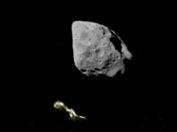
Posted by: Phil Stooke Sep 7 2008, 06:04 PM
Look at a page of text from a bit too far away to read the words, and you will see irregular white lines running over the page - "rivers" in printer jargon. They consist of chance alignments of spaces between words. This crater chain is just a chance alignment of craters. Proof - they are of different ages, as shown by the different degrees of sharpness and regularity.
Phil
Posted by: volcanopele Sep 7 2008, 06:56 PM
Very good point, Phil. If these are impact craters, that would be most likely explanation. These can't be secondary impacts, Steins has too little gravity to pull ejected material back in. Any material from that north polar impact crater would be long gone, except very slow moving ejecta...and they wouldn't form craters, those would show up as boulders on the surface (resolution too low to resolve these). As others have explained effectively, these likely aren't a crater chain caused by a broken-up impactor, Steins is too small, and rotates too slowly. And it would certainly NOT break up an in-coming body, Steins is not Jupiter. I'm willing to bet that Steins just about fills up its Roche lobe.
So you are back to either a pit chain, a la Phobos, or just a coincidental arrangement of craters.
Posted by: ugordan Sep 7 2008, 07:46 PM
Um... how do you calculate the Roche limit if it's the only isolated body around?
Posted by: volcanopele Sep 7 2008, 08:17 PM
.... don't ask math questions on a Sunday....
![]()
Posted by: 3488 Sep 7 2008, 10:44 PM
I like that VP, perhaps best not to ask ANY questions that require an intelligent answer on a Sunday. ![]()
I have been during quite a bit of gemming up on 2867 Šteins today, but not from Wikipedia.
2867 Šteins although not originally a part of 4 Vesta as per my first theory, does appear to be a chunk knocked off Asteroid 434 Hungaria, so my theory that 2867 Šteins is part of a mantle from a larger body, still stands.
Apparently some Hungaria asteroids do come close to the orbit of Mars, though 2867 Šteins, does not & remains a core member that stays well within the main Asteroid Belt, though E Type main Belt asteroids are incredibly rare, so Rosetta by some very remote & lucky chance encountered one, on only the eigth close asteroid pass (ninth including 243 Ida's moon Dactyl).
I wonder if someone knows. Does 2867 Šteins rotate prograde or retrograde? The Press Conference stated that 2867 Šteins has virtually no axial tilt, but did not mention direction of axial rotation.
If anyones interested, view of Sun & Earth from 2867 Šteins @ time of Rosetta Closest Approch.
Andrew Brown.
Posted by: Hungry4info Sep 8 2008, 12:33 AM
http://en.wikipedia.org/wiki/Roche_limit
What he was saying is that the point at which tidal forces would tear an asteroid into a string of asteroids SL9-style would probably be closer to the centre of the asteroid than the surface is.
Posted by: Decepticon Sep 8 2008, 02:26 AM
Can someone clarify if the camera safe mode cost the flyby of Hi-Res images?
Posted by: elakdawalla Sep 8 2008, 03:02 AM
I suppose it depends upon what you mean by Hi-res. If you mean "would we have higher-resolution images of Steins if the camera had not safed?" the answer is, I believe, yes. My understanding was that OSIRIS NAC was also to be used to image Steins throughout the encounter, so, in theory, we could have had images with 5x better resolution. Such is life. The WAC images are still pretty great, with the special treat of going through zero phase, which is probably making the spectroscopists drool.
I have a nagging memory that there was a New Horizons instrument that safed during the Jupiter flyby for a similar reason (safety tolerances set very conservatively, given the fact that Jupiter was not the prime target). Is this right? Does anybody remember which one?
--Emily
Posted by: mchan Sep 8 2008, 04:59 AM
What he was saying is that the point at which tidal forces would tear an asteroid into a string of asteroids SL9-style would probably be closer to the centre of the asteroid than the surface is.
This might make sense if the first use of "asteroid" in the sentence refers to an object apart from the second use of "asteroid" (singular) in the sentence.
Jason used the term "Roche lobe" instead of "Roche limit". The wikipedia describes the former in the context of a binary star system. This is still an effect between two bodies. Gordan was asking what Roche meant for a single body in isolation.
Posted by: lyford Sep 8 2008, 05:58 AM
http://pdsproto.jpl.nasa.gov/catalog/dataset/results.CFM?resultsselbox=NH-J-PEPSSI-2-JUPITER-V1.0?
Posted by: volcanopele Sep 8 2008, 08:50 AM
I used Roche lobe because I listen to the small icy moons people on the imaging team a little too much. It is used in context of small, fluffy moons that can't really accrete anymore.
Posted by: ugordan Sep 8 2008, 08:55 AM
That was my point exactly, an isolated object isn't prevented by outside tidal forces from continually accreting material as one would be if it were in say Saturn's orbit. Granted, there's a weak tidal effect by the Sun, but it's insignificant in this case.
Posted by: karolp Sep 8 2008, 09:54 AM
http://planetary.org/explore/topics/compare_the_planets/scale_1000000.html
It's far from complete, has various formatting issues, and breaks down toward the end. Also I notice that my Prometheus image seems to be mis-scaled.
--Emily
Hi Emily,
A friend of mine has done a similar job with the irregular moons of the Solar System. The derivative is copyright Andrzej Karon 2008:

He is also considering doing the same with asteroids.
Posted by: remcook Sep 8 2008, 10:05 AM
Amazing images! What a strange shape! It reminds me of someone pushing a thumb in a play-dough ellipsoid, pushing through such that the bottom gets a lump ![]() I wonder what made Steins look like that...
I wonder what made Steins look like that...
Posted by: cotopaxi Sep 8 2008, 10:09 AM
About the crater chain: Gravitational disruption is not the only mechanism for cometary breakup, so it could be possible, though admittedly unlikely, that a recently disrupted comet crashed into Steins. It's also notable that the scale is much smaller than for crater chains seen elsewhere (not clear if such small comets exist).
On the other hand, contrary to other posters, I find a chance alignment unlikely. Can anyone point me to a "chance alignment" of 7 or so craters out of the largest 20 or 30 on any other asteroid or moon?
We need some more quantitative analysis here.
About the loss of NAC images, it's like Emily said. The NAC at closest approach would have given factor ~5 better resolution than the WAC, 9 minutes before it's comparable to the WAC at closest approach. A rule of thumb says that one needs of
the order of 100 pixels for a good analysis of global properties, some topography, and so on. With the NAC it would have been around 300, with the WAC it's around 60.
Michael
Posted by: Phil Stooke Sep 8 2008, 10:52 AM
"Can anyone point me to a "chance alignment" of 7 or so craters out of the largest 20 or 30 on any other asteroid or moon? "
Famous example: the apparent chain of six large craters extending south from Ptolemaus on the central meridian of our moon, long touted as proof of their internal origin.
Look at the 'rivers' I mentioned above. Purely random chains you can see every day. Look at stucco. Randomness includes lots of apparent patterns.
Phil
Posted by: mchan Sep 8 2008, 01:29 PM
Karol,
That is a very eye-catching comparative diagram of the moons.
A small correction. The planetary symbol for Ganymede should be Jupiter, not Saturn! ![]()
Posted by: john_s Sep 8 2008, 02:49 PM
--Emily
That was Alice, the UV spectrometer. Background count rates due to Jovian radiation exceeded a pre-set conservative threshold so the instrument switched itself off. The flight team was able to upload a higher threshold value during the encounter, but by then background levels had fallen anyway. So we still got a fair amount of Alice data, including a very nice Jupiter stellar occultation early in the encounter, before the background got too high.
John
Posted by: cotopaxi Sep 8 2008, 04:03 PM
Famous example: the apparent chain of six large craters extending south from Ptolemaus on the central meridian of our moon, long touted as proof of their internal origin.
Look at the 'rivers' I mentioned above. Purely random chains you can see every day. Look at stucco. Randomness includes lots of apparent patterns.
Phil
The large craters south of Ptolemaus are much smaller relative to the size of the moon than the craters on Steins relative to Steins. So the likelyhood of finding some chain like this somewhere on the moon is much higher than finding what we see on Steins.
Posted by: centsworth_II Sep 8 2008, 05:25 PM
The scale problem has already been mentioned. The individual pieces of a random chain should be the same scale as the noise they emerge from. To my untrained eye, the chain on Steins seems to be made of craters of a different scale from most of the random craters.
Also, it's been mentioned that Steins does not have the strength to tear apart an impactor and that the pieces of an impactor torn apart by another body would not remain together. But what about a "rubble pile" impactor?
Posted by: ugordan Sep 8 2008, 05:27 PM
And that's how we come back to what I said earlier - look around long enough and you're bound to find it. I simply can't think of a plausible mechanism that would explain the crater chain as anything more than coincidence. The fact it runs perfectly along the terminator where shadows are brought up is very much ignored here. For all I know, there could be other "linear chains" waiting to be seen if you change the illumination a bit. Maybe even high speed turtles, who knows?
Frankly, I find it a bit surprising to see people still see this alignment as something telling/significant, but don't let that stop you.
Posted by: centsworth_II Sep 8 2008, 05:32 PM
Good point.
Hey. At least we don't see a face (or a high speed turtle).
Posted by: cotopaxi Sep 8 2008, 06:20 PM
It is true that I did not consider illumination conditions and that the reality of the chains is more of a "gut feeling" that may not survive detailed analysis. However, the craters in the chain are large enough to be seen anywhere on the imaged hemisphere, and the asteorid appears far from saturation with craters of that size (otherwise you could indeed easily find those chains). Also, they are of about equal size and spacing, reminiscent of the chains on the galilean moons. And that you (and I) cannot think of a plausible mechanism does not necessarily mean that there is none.
Posted by: Juramike Sep 8 2008, 06:40 PM
Hello? Hello? (taps microphone) Is this thing on?
Posted by: ugordan Sep 8 2008, 06:48 PM
Again, this is my point. More overhead illumination makes the other craters not stand out so well. For what it's worth, the images widely distributed are magnified so they are blurred and hide the actual pixel scale and make you think small details are not there (when they're actually below resolving power). Here's the actual pixel scale view, magnified 3x using the nearest-neighbor algorithm in order not to add new "details" into the image.
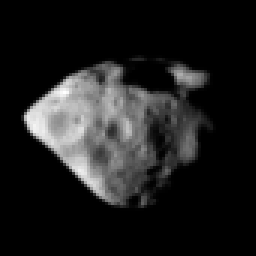
I'm seeing several craters of similar size across the face, but they don't poke the eye because they're not on the terminator. The chain craters you speak of do absolutely not appear of the same size to me, the lower 3 ones appear much bigger than the top 4. Yet, the top 4 have a companion off to the left side with also a hint of a fifth crater almost completely shadowed. As far as I'm concerned this case is closed.
EDIT: Mike, I didn't mean you, I meant the rest of the folks who believe this feature isn't accidental.
Posted by: JRehling Sep 9 2008, 12:47 AM
Misc. Steins thoughts:
1) The rotation means that the gravity along the "equator" would be about 10% less than at the "poles", assuming a density of 2 g/cm^3.
2) If Steins formed as the fragment of impacts between larger bodies, there could be craters from secondary impacts that occurred precisely at the time of origin as a lot of fragments were briefly on similar trajectories.
3) Phil's comment trumps all: The "chain" craters are not of the same age, so they don't have the same origin.
4) Is everyone pronouncing it "SHTINES" like they should? There's a hacek over that "S"!
Posted by: tedstryk Sep 9 2008, 01:16 AM
Where did you see that?
Posted by: elakdawalla Sep 9 2008, 01:57 AM
I've seen it on one website (and now can't remember which one) but I do remember noticing that only Rita Schultz pronounced it that way on the ESA press panel.
--Emily
Posted by: David Sep 9 2008, 02:47 AM
Unfortunately, that's wrong too. It's not a German name, it's a Latvian one (although I suppose its origin is ultimately German). In Latvian, ei = (approximately) the ei in eight. The final s should be voiceless too. So it should be "shtains" (not "shtainz", but with the same final consonants as in "rinse" or "glance") -- it sort of rhymes with "saints", if you muddle away the t. It's named for the Latvian astronomer Kārlis Šteins.
Posted by: elakdawalla Sep 9 2008, 03:13 AM
Huh. Anybody out there disagree with this, or is it the final answer? I'm planning on talking about Shtainss in my Wednesday Ustream show, and I'd like to make an honest attempt to get it right ![]()
--Emily
Posted by: JRehling Sep 9 2008, 03:54 AM
I got suckered in by the hacek -- I have a passing familiarity with Czech, but not Latvian.
Czech writes every word phonetically, and since German pronounces every S before a "t" as /sh/, words that are borrowed from German (like "Stein", which means "stone"), are written with the s+hacek (not sure if I type it here if everyone will see it that way).
Now here's ( http://en.wikipedia.org/wiki/Karlis_Steins ) the page on the astronomer it's named after and the Cyrillic indicates that it is pronounced "SHTINES", but I'll take David's word for it on the Latvian. I would guess that in the USSR, Russian names trumped other languages' pronunciations, but that was then and this is now.
It sort of seems like this name probably hasn't been spoken aloud that often over the years, which makes the notion of proper pronunciation almost degenerate. Rita Schultz is German, and moreover has a last name starting with that same sound, so I'm not surprised that she'd pronounce it according to its German origin.
Posted by: ElkGroveDan Sep 9 2008, 05:08 AM
If you'd rather not, I know of a great new household product guaranteed to get the "Shtainss" out.
Posted by: jumpjack Sep 9 2008, 06:51 AM
http://img247.imageshack.us/my.php?image=steinsexplzu2.jpg
This would explain why the asteroid didn't get destroyed by an impact which created a crater large 40% of its size! (consider very low gravity of such a small body).
It looks like my hypothesis is actually possible!
http://www.space.com/scienceastronomy/080908-mm-comets-as-asteroids.html
Could Rosetta instruments detect Steins surface temperature?
Posted by: jumpjack Sep 9 2008, 07:00 AM
A friend of mine has done a similar job with the irregular moons of the Solar System. The derivative is copyright Andrzej Karon 2008:
Really nice image; it would be interesting to see how Pluto appears in this scale, although it's not a moon.
I think I'll try to set up a single image collecting all bodies smaller than 6000 km...
Posted by: mps Sep 9 2008, 07:55 AM
I think the Cyrillic actually supports David's version.
Posted by: ugordan Sep 9 2008, 08:05 AM
I concur.
Posted by: cotopaxi Sep 9 2008, 10:42 AM
I'm seeing several craters of similar size across the face, but they don't poke the eye because they're not on the terminator. The chain craters you speak of do absolutely not appear of the same size to me, the lower 3 ones appear much bigger than the top 4. Yet, the top 4 have a companion off to the left side with also a hint of a fifth crater almost completely shadowed. As far as I'm concerned this case is closed.
EDIT: Mike, I didn't mean you, I meant the rest of the folks who believe this feature isn't accidental.
I am afraid I am starting to sound like a broken record, so I promise this is my last post on the subject. I understand that the craters are most obvious at the terminator, and yes, we see 20 or so craters on the surface. The point is, the
alignment of 7 of them is too good to be an OBVIOUS change alignment. On Ganymed or Callisto there are lots of craters the same size as the accepted crater chains. The criterion is the fractional surface coverage, and that is low.
I don't say it cannot be a chance alignment, I am only objecting against the "case being closed".
Posted by: 3488 Sep 9 2008, 01:08 PM
It will be interesting to see the results of the gravity data (slight deflection of Rosetta), the NAC images prior to safing & the multispectral data.
An encounter montage I've made of the Asteroid 2867 Šteins.
I know, not as good as many if not all of the contributions on this thread, but I do try. ![]()
Using screen dumps from the ESA animation. Not raw screen dumps as I have enlarged each one by 350% & have enhanced the contrast slightly, all equally.
Andrew Brown.
Posted by: tedstryk Sep 9 2008, 02:04 PM
Where did you find that information (I am not being sarcastic, but I keep coming up empty when I try to find background information on Stein's discoverer)?
Posted by: Juramike Sep 9 2008, 02:17 PM
Without more extensive imaging or a deeper peer-reviewed analysis, I wouldn't feel comfortable "closing the case" either way.
[Personally, I prefer the term "resting a case" rather than "case closed" - when new information pops up, anything/everything can be re-evaluated.]
I would be very interested to know if other crater chains have been observed on other asteroids. Or is the "tentative observed alignment of circular features" (safest statement I could come up with) on Steins a unique case?
-Mike
Posted by: jamescanvin Sep 9 2008, 02:46 PM
I haven't dug up the references but there are two listed in the Wikipedia entry for http://en.wikipedia.org/wiki/Karlis_Steins the Latvian astronomer, linking him to 2867 Šteins.
Posted by: JRehling Sep 9 2008, 05:44 PM
I also agree that the Cyrillic backs up just what David said. I misread a detail in his post.
Posted by: Phil Stooke Sep 9 2008, 05:56 PM
I'm returning to the crater chain discussion. Nobody should feel bad about discussing observations like this - it's actually a fascinating example of perception in science. How do we know what to believe when we look at an image? The observation that craters are aligned is absolutely true. Experience with such observations leads me and others to suggest it doesn't mean anything. But in another setting it might be perfectly real.
A good example was an old post by our own dvandorn, which I can't find right now. He said that Cassini's medium-close images of Hyperion showed numerous crater chains. I thought he was hallucinating (sorry Doug!) until I looked again, and he was absolutely right. Those chains are not like these on Steins, they were straighter and more uniform in size and appearance. What are they? I still don't know. But I think they are real.
Anyway, back to Steins. Here's another complication. Which of the two alignments in these images should be counted as the crater chain? Because the surface curves, different combinations of craters can appear aligned depending on the viewpoint. From my point of view this weakens the significance of the observation, but another interpretation might be that there are multiple alignments. Note too, another alignment in the right-hand image, sharply tilted relative to the red line. It looks less convincing in the other image.
Phil
Posted by: siravan Sep 9 2008, 08:37 PM
I think the best way to wrap-up the discussion to this point is to use Sherlock Holmes rule: "when you have eliminated the impossible, whatever remains, however improbable, must be the truth". In this setting, when there is no viable explanation for a crater chain on Steins, given iffy alignment of the craters to begin with, and proximity to the terminator, the most logical explanation is that it is just a random alignment (in fact, Sherlock Holmes rule is even an overkill here, as it is not an improbable situation, rather, it is very porbable).
My question is that if the same crater "chain" was observed on a body where a plausible explanation was available (e.g. on an inner moon of Jupiter or Saturn), would it be discarded as readily?
Posted by: jasedm Sep 9 2008, 09:02 PM
I know, not as good as many if not all of the contributions on this thread, but I do try.
Andrew Brown.
Thanks for the montage Andrew - every image on this site is informative and useful.
Posted by: JRehling Sep 9 2008, 09:08 PM
In questions that are sufficiently quantitative, tests of statistical significance have been the gold standard. But it's hard to know which test to apply here, which may mean in part that we haven't framed the question as specifically as we could.
What *is* "a crater chain"? It doesn't have to be straight. On a body like this, "straight" itself is somewhat dubious. I guess the key question here is if these impacts occurred relatively simultaneously due to impactors of a common origin. Suppose a cometary chunk fragmented in a cluster rather than a linear pattern so soon before impacting Steins that they had no time to separate before the impacts. You might get a shotgun blast of craters that aren't linear at all, but still have the characteristic of the origin of a chain.
Would this count as a "crater chain" if the impactors were moving very, very slowly relative to Steins? Eg, if a primary impact left a cluster of material that continued in a solar orbit near Steins and only gradually impacted later?
I guess we need to frame the question very precisely before we could summon up a statistical test of whether or not the observation validates the hypothesis. The thing that makes this unscientific is that we already have the data and are theorizing after the fact.
Posted by: David Sep 9 2008, 11:59 PM
I'm afraid I know almost nothing about Nikolai Chernykh either! Other than that he discovered a whole lot of asteroids.
As far as Šteins himself goes, there is a short and not very enlightening mini-bio in Russian http://www.astronet.ru/db/msg/1219766
Posted by: ngunn Sep 10 2008, 11:54 AM
Apologies if this has already been asked. Could the bump at the south pole have been created by material punched straight through by the impact that produced the north pole crater? I realise there is no need for such a hypothesis and that it's probably untestable in any case. Just wondering if it's possible in principle.
Posted by: ugordan Sep 10 2008, 09:27 PM
A quick attempt to register the color composite a bit better, original composite snatched from Emily's http://planetary.org/news/2008/0909_Rosetta_Unearths_a_Jewel_of_the_Solar.html:
So yeah, almost completely gray with hints of color pretty much coming from noise.
Posted by: elakdawalla Sep 10 2008, 09:38 PM
Thanks for that, ugordan.
For those of you who are native speakers of eastern European languages: I'm looking for a volunteer with a mic who could record pronunciations of Steins and also of Churyumov-Gerasimenko. I'd like to post them on the Society website.
--Emily
Posted by: ugordan Sep 10 2008, 09:43 PM
FWIW, I thought you did a fine job at pronouncing Šteins in the Ustream chat. I have absolutely no idea on how to pronounce C-G on the other hand. ![]()
Posted by: David Sep 11 2008, 01:08 AM
I found this http://www.youtube.com/watch?v=-lITTbie0GI which is a clip from a Russian news segment about Rosetta. At 00:32 to 00:34 you can hear the newsreader trying to say "Churyumov-Gerasimenko". Of course, he mispronounces Šteins with an S (doubtless because it's misspelled in his copy), so you can make what you want of it.
The newsreader places the accents as follows: ChurYUmov-GerasiMENko.
(My Russian pronunciation is not very good; my best approach would probably sound like "choor-YOO-muff ghee-rah-see-MYENka".)
Posted by: JRehling Sep 11 2008, 04:05 AM
FWIW, some Eastern European languages are sufficiently dissimilar to Russian that any ability a native speaker of that language would have to pronounce Russian would be purely circumstantial! (Sort of like asking someone from Iowa how to pronounce Swedish.)
Posted by: jumpjack Sep 11 2008, 06:27 AM
Try posting in this Russian forum:
http://engforum.pravda.ru/
(if you don't mind being offended once they figure out you're american... ![]() )
)
Posted by: Paolo Sep 11 2008, 07:25 PM
Why is APL missing from the montage? It was more or less resolved by New Horizons, just like Braille
Posted by: tedstryk Sep 11 2008, 10:56 PM
The resolution is much poorer for the asteroid NH imaged. Braille is just a tiny asteroid, but the resolution of the images was not bad - ~2 km/pixel.
Posted by: Phil Stooke Sep 12 2008, 01:06 AM
There's a new Steins image on the ESA site, from NAC. Low resolution but a bit earlier than the first WAC image.
Phil
Posted by: elakdawalla Sep 12 2008, 01:10 AM
Hi Phil, can you provide a link? I didn't see it on the homepage.
Posted by: volcanopele Sep 12 2008, 01:30 AM
http://sci.esa.int/science-e/www/object/index.cfm?fobjectid=43380
Posted by: Rakhir Sep 12 2008, 12:49 PM
And some details on the fly-by manoeuvres:
http://sci.esa.int/science-e/www/object/index.cfm?fobjectid=43369
Posted by: cndwrld Sep 12 2008, 01:09 PM
The ESA SciTech newsletter that just came out includes the above plus another:
+ Details of the astonishing Rosetta fly-by of asteroid Steins can be read in "Rosetta Status Report No. 104 - Asteroid Steins Fly-by". This includes details of the asteroid fly-by manoeuvres which enabled the spacecraft to continuously keep asteroid Steins in the field of view of Rosetta's imaging instruments, while the spacecraft flew past the asteroid at a relative speed of 8.6 km per second.
http://sci.esa.int/jump.cfm?oid=43369
+ A colour composite image taken with the OSIRIS Narrow Angle Camera approximately 10.5 minutes before closest approach has been released.
http://sci.esa.int/jump.cfm?oid=43380
+ The first images of asteroid Steins, taken by the OSIRIS Wide Angle Camera during the fly-by of 5 September, were presented at a press conference the following day.
http://sci.esa.int/jump.cfm?oid=43361
Posted by: 3488 Sep 12 2008, 11:38 PM
FWIW, I've enlarged & sharped a bit the view of 2867 Šteins, approx 10.5 minutes prior to CA & 9,500 KM using the NAC prior to safing.
Also here, brightness reduced & contrast enhanced. Shows the cavity quite well.
Andrew Brown.
Posted by: Harkeppler Sep 24 2008, 01:46 PM
The jovian moon Thebe (here seen by Galileo) seems to show a nice similarity to asteroid 2867 Šteins: a large impact structure on an axis of symmetry and a conical end opposite to this crater.
Posted by: tasp Sep 24 2008, 06:26 PM
Would that Thebe impact have consolidated materials not blasted out of the crater into a more resilient form that we now observe as the balance of the former larger Thebe that was chipped away by subsequent rocks ??
Mechanical shock effects might have 'welded' loosely compacted materials surrounding the crater into the form we now see. Maybe something similar happened to Steins, and perhaps many asteroids have this heritage.
Posted by: 3488 Sep 24 2008, 07:32 PM
I suspect Thebe is a rubble pile held together by gravity. The 'pointy' end could be a 'shattercone' where at that end of the original larger object the impact that broke it occurred. With Thebe I have problems with that, i.e the giant crater suggests a rubble pile, not a shattered but hard body.
2867 Šteins, could be a shattercone, possibly once a part of the original larger Asteroid 434 Hungaria (which is now approx 20 KM in diameter).
Enormous deep craters are not that unusual.
Here is a montage I made of the Type C main belt Asteroid 253 Mathilde.
It is known that 253 Mathilde is of very low density, a 'rubble pile' held together, so the porous nature of the asteroid absorbs impacts like punching in polystyrene.
2867 Šteins, I'm not sire. I have not seen any gravity data from Rosetta. The volume of 2867 Šteins is known through the images, so using those together with pertubation data will yield the density. Or was Rosetta passing by too quickly to feel the tug from 2867 Šteins?
Perhaps if the NAC had worked, then greater detail of that 'large' crater on 2867 Šteins, may have helped determine if it's a hole in a rubble pile or was blasted out of more solid, but brittle material.
I assume 2867 Šteins is still thought of being composed of iron poor silicate rich basalt?
243 Ida also has a large crater, but the Galileo data suggested that 243 Ida was too dense to be a rubble pile, but perhaps some parts of the asteroid are not so coherent?
Also Mammoth Crater on main belt Asteroid 243 Ida. Some large boulders are visible.
Andrew Brown.
Posted by: cotopaxi Sep 24 2008, 10:21 PM
Since this has come up a few times: Unfortunately Rosetta is not able to determine the mass (and therefore density) of Steins from the acceleration of the spacecraft by the asteroid. Flyby distance and velocity are too high, given the size of the asteroid.
Posted by: ngunn Sep 25 2008, 07:22 PM
I notice that this colour image posted by Doug on the planetary society blog works rather well as a 3D anaglyph if you reverse the specs - right eye red:
http://planetary.org/image/steins_color.png
(Great stuff from the conference Doug - and I'm sure your presentation made a few converts.)
Posted by: djellison Sep 25 2008, 08:07 PM
Emily was kind enough to be my copy-editor, picture-editor, arbitrator of facts - she dropped that image in ![]()
Posted by: tedstryk Aug 10 2009, 02:58 PM
I apologize in advance if this is a repost, but this is the most complete Steins WAC stet I have seen.
Posted by: elakdawalla Aug 10 2009, 04:21 PM
That montage rang a bell -- with a little searching I realized that I made it! I composed it by grabbing the individual frames from the animation of the flyby that ESA posted http://www.esa.int/SPECIALS/Rosetta/SEMNMYO4KKF_0.html. http://www.planetary.org/blog/article/00001637/
--Emily
Posted by: tedstryk Aug 11 2009, 12:47 AM
And here I thought ESA had made a new release ![]()
Posted by: Paolo Dec 27 2009, 09:34 AM
Reading the paper on Hubble observations of asteroid Lutetia (see parallel thread "Rosetta flyby of Asteroid Lutetia" I noticed that results from the Steins flyby are due for publication in 2010 (at last!) in "Science" and in a dedicated issue of "Planetary and Space Science"
Posted by: Paolo Jan 8 2010, 06:09 AM
In Science today: http://www.sciencemag.org/cgi/content/abstract/327/5962/190
Posted by: Antdoghalo Jan 10 2010, 12:44 AM
Anyone know where a free version of that article is
Posted by: elakdawalla Jan 10 2010, 06:47 AM
Nope but if you're lucky someone who does have access to the article will write an informative blog entry on the paper before long ![]()
Posted by: Antdoghalo Jan 10 2010, 09:24 PM
If theres a map please include it.
![]()
![]()
Posted by: Roby72 Jan 10 2010, 09:51 PM
I could find this short notice:
http://www.mpg.de/bilderBerichteDokumente/dokumentation/pressemitteilungen/2010/pressemitteilung201001051/index.html
Robert
Posted by: Phil Stooke Jan 10 2010, 11:52 PM
No, there is not a map. But a map was shown at DPS 2008 and will undoubtedly be included in the set of papers due to be published in Planetary and Space Science soon. I have the map but I don't think it would be OK to post it here.
Phil
Posted by: Antdoghalo Jan 11 2010, 05:52 AM
Phil
Why not?
Posted by: ElkGroveDan Jan 11 2010, 06:03 AM
...and why can't I have a pony?
Posted by: Stu Jan 11 2010, 06:29 AM
Ant,
"Why not?"
Here's a tip: before quizzing people like that, take a look at how long they've been a member of the forum and what their status is. If they've been here for quite a few years, and aren't a relative newcomer, the chances are that you can trust them - and don't have to ask for an explanation - when they say they can't do something. And you can trust me when I tell you that here on UMSF we are MASSIVELY priviliged to have access to many maps, colourisations, animations and other image products that are pretty much ONLY available here, so there's no point in bemoaning the lack of something.
If it's out there at all, it'll be available eventually, that's how it works.
Posted by: Juramike Jan 11 2010, 04:39 PM
I'll also chime in that some of the products are still being actively researched and validated and are not yet ready for prime time.
Generally a good rule is to "never e-mail or post something you wouldn't spray paint on a freeway overpass". Once an image or graphic is released, it is in the public domain. Some publications, like Nature and Science, won't even touch an article if the work has been previously presented.
Even worse, there has been at least one instance where material presented in the UMSF forum was incorporated into an active research program without full acknowledgment (or even the author's knowledge).
We are very fortunate to have both talented amateurs and active professionals that contribute to this forum. But that also implies that some of the information exchanged will need to be carefully limited as the research programs and artistic endeavors dictate.
-Mike
Posted by: Stu Jan 11 2010, 04:49 PM
It's really pretty simple: don't moan, because compared to how things used to be, we're all already spoiled absolutely rotten.
Posted by: elakdawalla Jan 11 2010, 07:06 PM
http://www.mpg.de/bilderBerichteDokumente/dokumentation/pressemitteilungen/2010/pressemitteilung201001051/index.html
Robert
Thanks, Roby72! The automated Google translation of this page produces the words "garbage dump" where I would expect to read "rubble pile"
Posted by: Paolo Jan 12 2010, 06:09 AM
In the latest Astronomy & Astrophysics (and available for free) http://www.aanda.org/articles/aa/abs/2010/01/aa13549-09/aa13549-09.html
Posted by: Dominik Jan 13 2010, 12:22 AM
@Emily
I've checked the translation of the German word "Schutthalde" and the best translation for this word is "rubble tip".
Unfortunately, the Google translator isn't that good when you try to translate German text into English. ![]()
Posted by: imipak Jan 13 2010, 07:54 PM
Fortunately, there's a "Help improve this translation" button, too ![]()
Posted by: Paolo Mar 30 2010, 05:11 AM
on arXiv today http://arxiv.org/abs/1003.5655
Posted by: cotopaxi Jun 17 2010, 08:42 AM
The special issue of Planet. Space Science on the Steins flyby is now available on
http://www.sciencedirect.com/science/journal/00320633
Posted by: Phil Stooke Jun 17 2010, 02:43 PM
Since the Rosetta team's map of Steins is now published:
Search for Steins’ surface inhomogeneities from OSIRIS Rosetta images
Pages 1097-1106
C. Leyrat, S. Fornasier, A. Barucci, S. Magrin, M. Lazzarin, M. Fulchignoni, L. Jorda, I. Belskaya, S. Marchi, C. Barbieri, U. Keller, H. Sierks, S. Hviid
I can now post my version. The pointy end of Steins is the north pole, so pictures of it are often shown south-up (defined by rotation direction). My map differs from the official one a bit at the south pole because I interpret the southern horizon features differently.
This has zero meridian in the middle, 180 long. at the ends, north up, simple cylindrical projection.
Phil
Posted by: Stefan Oct 22 2010, 02:40 PM
I hope you enjoy this collection of Steins anaglyphs, published in the Steins P&SS special issue:
Posted by: monty python Oct 23 2010, 07:42 AM
I LOVE my 3d gasses!
Brian.
Posted by: tedstryk Oct 24 2010, 02:11 AM
Brian.
Glasses might work better.
Posted by: monty python Oct 24 2010, 07:05 AM
I could make a nitrous oxide joke here but I'm just too humiliated!
Brian
Posted by: peter59 Jul 4 2011, 01:08 PM
Asteroid 2867 Steins - NAC raw data.
http://pdssbn.astro.umd.edu/holdings/ro-a-osinac-2-ast1-steinsflyby-v1.4/dataset.html
Posted by: elakdawalla Jul 4 2011, 02:42 PM
Woo hoo! But just before I go on vacation, argh!
Posted by: machi Jul 4 2011, 03:28 PM
And here are http://pdssbn.astro.umd.edu/holdings/ro-a-osiwac-2-ast1-steinsflyby-v1.4/.
Thanks Peter for link and OSIRIS team for images! Finally some nice data from Rosetta!
Posted by: djellison Jul 4 2011, 07:20 PM
And img2png works!
This is from Oct 2008 - a microlensing experiment looking at the galactic center - a mosaic of frames from the NAC
Larger version here : http://twitpic.com/5l855t/full
Ludicrously long data credit: : MPS/UPD/LAM/IAA/RSSD/INTA/UPM/DASP/IDA
Posted by: hendric Jul 5 2011, 09:15 PM
Cool, I was just looking at that H shaped open cluster on the left a few nights ago! That's M7.
http://seds.org/messier/m/m007.html
Posted by: machi Jul 6 2011, 01:46 AM
"This is from Oct 2008 - a microlensing experiment looking at the galactic center - a mosaic of frames from the NAC"
It looks great, but with my stupid internet connection, I cannot download more than half, then twitpic disconnect me ![]()
But luckily this isn't problem with PDS archive, so I finally download some raw images and this is first result (it's same image but with different brightness and contrast):
Superresolution image from last five frames from NAC camera (distance around ~5400 km). Resulting images were 2.5× magnified.
Posted by: machi Jul 7 2011, 01:05 AM
Enhanced version of the previous image. Now it has color from calibrated images (orange, IR, green and blue filters).
Posted by: Phil Stooke Jul 7 2011, 02:39 AM
Those are really nice! Thanks.
Phil
Powered by Invision Power Board (http://www.invisionboard.com)
© Invision Power Services (http://www.invisionpower.com)

